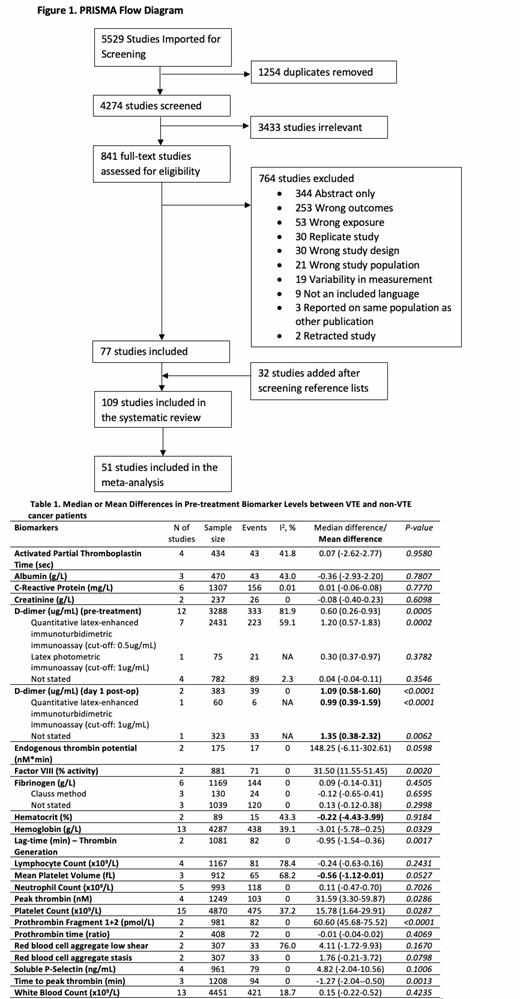Patients with cancer have an increased risk of venous thromboembolism (VTE). Currently, several VTE risk prediction tools have been developed to identify candidates for primary VTE thromboprophylaxis. However, the availability of reliable and highly discriminatory prediction models for VTE risk assessment in cancer patients is limited, warranting further improvement of VTE risk stratification strategies. The implementation of biomarkers in risk assessment models might lead to refined VTE risk prediction, but it remains to be more comprehensively investigated. In this systematic review and meta-analysis, we aimed to evaluate and summarize all candidate biomarkers and their association with cancer-associated VTE.
We conducted an electronic search in Medline, EMBASE and Cochrane central databases for studies that evaluated biomarkers in adult patients with cancer from inception to September 26 th 2022. We included observational and interventional studies reporting on subsequent VTE occurring after a cancer diagnosis. The baseline or index event of the biomarker measurements had to be definitively and uniformly applied to all enrolled patients. Two reviewers independently screened titles, abstracts and full-text articles for inclusion. Median differences (for continuous measures) and Odds Ratios (OR) (for dichotomous cut-off measures) with 95% confidence intervals (95% CI) were estimated and pooled using random-effects models. We assessed each studies risk of bias using the Quality in Prognostic Studies (QUIPS) risk of bias tool.
Our search identified 4274 studies that were screened for inclusion (Figure 1). Following the screening, 109 studies (with 520 biomarker measurements) met the inclusion criteria and were included in the systematic review. Of these, 51 studies (with 174 biomarker measurements) were included in the meta-analysis. The majority of the studies were cohort studies (n=47; 32 prospective and 15 retrospective), while the other 4 studies were nested case-control studies. Eighteen studies had a study population of mixed cancer types and the remaining studies had a study population of specific cancer types, including: lung (n=6), gynecologic (n=5), breast (n=3), stomach (n=3), lymphoma (n=2), myeloma (n=2), ovarian (n=2), pancreas (n=2), brain (n=1), colorectal (n=1), gastrointestinal (n=1), genitourinary (n=1), gynecologic or breast (n=1), head and neck (n=1), liver (n=1), and prostate (n=1). We calculated the median difference and 95% CI for 23 different biomarkers.
Cancer patients who experienced subsequent VTE events had significantly higher pre-treatment factor VIII activity, peak thrombin, platelet count and prothrombin fragment F1+2 levels compared to patients who did not experience VTE events (Table 1). Pre-treatment d-dimer levels were also higher in cancer patients who developed VTE, however, considerable heterogeneity was observed (Table 1). Contrastingly, pre-treatment hemoglobin, lag time - thrombin generation, prothrombin time and time to peak thrombin levels were significantly lower in those experiencing VTE events compared to patients who did not experience any events (Table 1). D-dimer levels on day-1 after cancer surgery were reported in two studies which, when pooled, revealed that cancer patients with subsequent VTE had higher d-dimer levels post-operatively compared to those with no events (Table 1). Moreover, pre-treatment hemoglobin levels 100 g/L was significantly associated with future VTE risk [OR: 1.42 (95%CI: 1.03-1.97), I 2=0%, n=11] while neutrophil lymphocyte ratio 3 was associated, yet insignificant [OR: 1.60 (95%CI: 0.99-2.60), I 2=43%, n=4]. Pre-treatment platelet count 350 x 10 9/L and white blood count levels 11 x 10 9/L were not significantly associated with future VTE risk [OR: 0.84 (95%CI: 0.66-1.06), I 2=0%, n=9 and 1.32 (0.86-2.03), I 2=56%, n=8, respectively]. From the 51 studies included in the meta-analyses, 27 studies had a low risk of bias, 19 studies had a moderate risk of bias and 5 studies had a high risk of bias.
In conclusion, nine blood biomarkers were found to be significantly associated with VTE in cancer patients. Their utility as predictors of VTE in thrombotic risk assessment models may help in optimising VTE prediction and should be further explored in future studies.
Disclosures
Wang:Leo Pharma: Research Funding; Valeo: Honoraria.


This feature is available to Subscribers Only
Sign In or Create an Account Close Modal